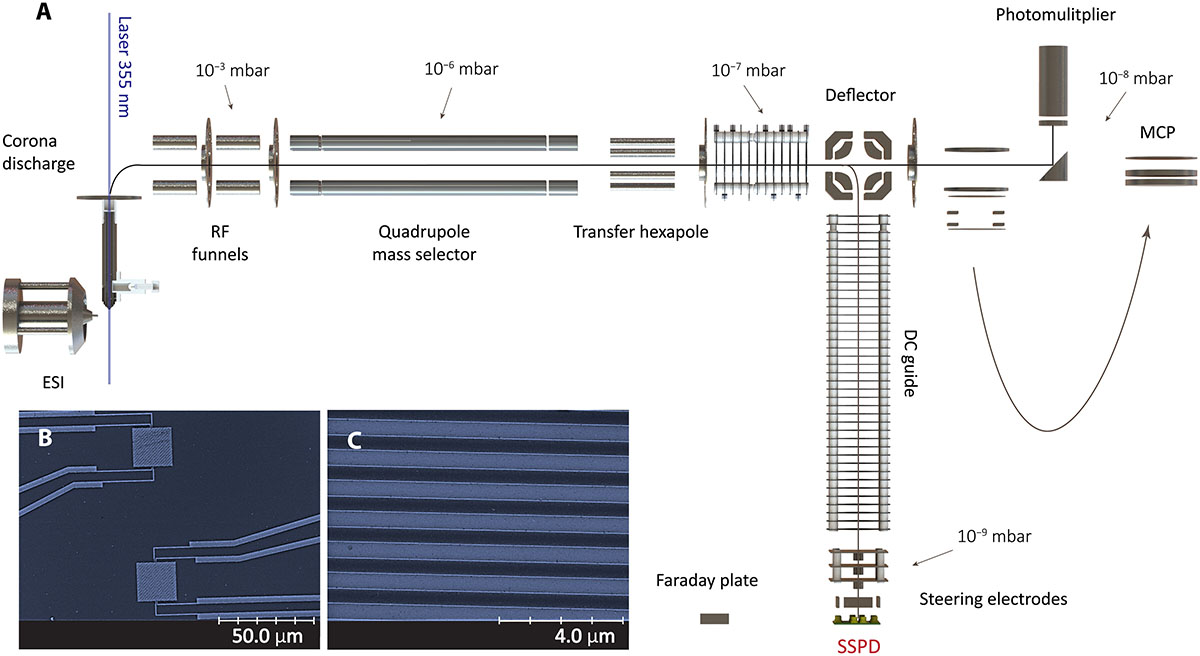| Dec 04, 2023 |
Superconducting nanowires detect single protein ions
(Nanowerk News) An international research team led by quantum physicist Markus Arndt (University of Vienna) has achieved a breakthrough in the detection of protein ions: Due to their high energy sensitivity, superconducting nanowire detectors achieve almost 100% quantum efficiency and exceed the detection efficiency of conventional ion detectors at low energies by a factor of up to a 1,000.
|
|
In contrast to conventional detectors, they can also distinguish macromolecules by their impact energy. This allows for more sensitive detection of proteins and it provides additional information in mass spectrometry.
|
Key Takeaways
|
|
Breakthrough in protein ion detection using superconducting nanowire detectors, significantly outperforming conventional methods.
New detectors achieve nearly 100% quantum efficiency, greatly enhancing sensitivity, especially at low energies.
Ability to distinguish macromolecules by impact energy, providing additional insights in mass spectrometry.
Superconducting state of nanowires enables lossless current flow and sensitive detection, revolutionizing macromolecule analysis.
Potential for wider application in life sciences, offering improved spatial resolution and detection capabilities.
|
 |
| Quadrupole mass spectrometry with superconducting single particle detection. (A) Proteins are volatilized using electrospray ionization charge-reduced in bipolar air by a corona discharge. Further charge reduction by photochemistry is enabled by a high-power ultrafast ultraviolet laser interacting with the molecules in the entrance chamber. The ions are filtered in a quadrupole mass selector and pass through a radio frequency hexapole guide toward a quadrupole deflector. The ions are then steered to either a TOF-MS with multichannel plate (MCP), a phosphor screen with photo-multilpier (PhS), or the SSPD array. A Faraday plate can be shifted into the position of the SSPD to calibrate the incident ion current at high flux. Panel (B) shows an electron micrograph of two pixels (SSPDs), each with a size of 20 × 20 µm2 (D1), while (C) shows a close-up image of a detector pixel (D2) that has a 100 times larger area and a 500-nm line width, as also described in the text. (click on image to enlarge)
|
The Research
|
|
The results of this study were recently published in the journal Science Advances ("Highly sensitive single-molecule detection of macromolecule ion beams").
|
|
The detection, identification, and analysis of macromolecules is interesting in many areas of life sciences, including protein research, diagnostics, and analytics. Mass spectrometry is often used as a detection system – a method that typically separates charged particles (ions) according to their mass-to-charge-ratio and measures the intensity of the signals generated by a detector. This provides information about the relative abundance of the different types of ions and therefore the composition of the sample.
|
|
However, conventional detectors have only been able to achieve high detection efficiency and spatial resolution for particles with high impact energy – a limitation that has now been overcome by an international team of researchers using superconducting nanowire detectors.
|
Joined forces for low energy particles
|
|
In the current study, a European consortium coordinated by the University of Vienna, with partners in Delft (Single Quantum), Lausanne (EPFL), Almere (MSVision) and Basel (University), demonstrates for the first time the use of superconducting nanowires as excellent detectors for protein beams in so-called quadrupole mass spectrometry. Ions from the sample to be analyzed are fed into a quadrupole mass spectrometer where they are filtered.
|
|
"If we now use superconducting nanowires instead of conventional detectors, we can even identify particles that hit the detector with low kinetic energy," explains project leader Markus Arndt from the Quantum Nanophysics Group at the Faculty of Physics at the University of Vienna. This is made possible by a special material property (superconductivity) of the nanowire detectors.
|
Getting there with superconductivity
|
|
The key to this detection method is that nanowires enter a superconducting state at very low temperatures, in which they lose their electrical resistance and allow lossless current flow. Excitation of the superconducting nanowires by incoming ions causes a return to the normal conducting state (quantum transition). The change in the electrical properties of the nanowires during this transition is interpreted as a detection signal.
|
|
"With the nanowire detectors we use," says first author Marcel Strauß, "we exploit the quantum transition from the superconducting to the normal conducting state and can thus outperform conventional ion detectors by up to three orders of magnitude."
|
|
Indeed, nanowire detectors have a remarkable quantum yield at exceptionally low impact energies – and redefine the possibilities of conventional detectors: "In addition, a mass spectrometer adapted with such a quantum sensor can not only distinguish molecules according to their mass to charge state, but also classify them according to their kinetic energy. This improves the detection and offers the possibility for have better spatial resolution," says Marcel Strauß.
|
|
Nanowire detectors can find new applications in mass spectrometry, molecular spectroscopy, molecular deflectometry, or quantum interferometry of molecules, where high efficiency and good resolution are required, especially at low impact energy.
|

